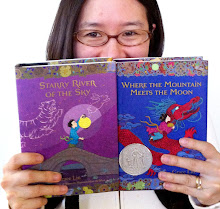And when I woke up we were at the Suzhou Silk Museum. Apparently, Suzhou is famous for their silk--the climate in that area is optimum for silk worms. They are able to harvest cocoons twice a season with much higher quantity and quality. The "Long History of Chinese Silk" begins here.


But the most fascinating part of the museum was the tour of a real working silk factory. Even though I knew where silk came from, the process never struck home until I actually saw it being made in front of me.

Because silk really comes from silk worms. Those cocoons are separated from those ugly little larvae and are used in one of two ways--to make silk thread or to make silk padding.
To make silk thread, the cocoons are assembly lined boiled. This loosens the strands of the cocoon,

allowing the workers to find an end to begin the machine unwinding process, making silk thread.
These threads are dyed and woven using these looms, making silk cloth.
The process for silk padding for quilts is a little different. The worm larvae is separated by hand from the quilt, and after being thoroughly soaked it is stretched over that U-shaped hoop that Melody is touching. After 100 cocoons are stretched over the hoop, it is taken off, dried...
and then stretched by hand to make the inner padding for a quilt. They let us pull one of the skeins and it was rather a thrill. It takes at least 8,000 cocoons to make enough padding for a quilt.
 And that ended our silk factory tour. It definitely gave us a new appreciation for silk; and I felt a lot smarter. Well, at least a lot smarter than I did that morning.
And that ended our silk factory tour. It definitely gave us a new appreciation for silk; and I felt a lot smarter. Well, at least a lot smarter than I did that morning.


3 comments:
Grace,
I went to a silk making factory in Suzhou, too! We also visited a beautiful garden while we were there. I wish we had been taken to the museum. I'm looking forward to hearing more about your trip when you return home. Enjoy the rest of your time there.
Wow, I had no idea. What a cool post! WHAT do they do with all the worms??
too bad ,i didn't go to Suzhou,but i went to Shanghai silk factory. I love silk, don't you ?
did you watch the fashion show in Suzhou ? what do you think ?
Post a Comment